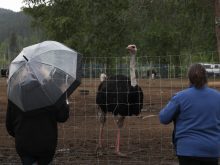At least two provinces now have bans in place on birds being brought to fall ag fairs and other such events, as cases of highly pathogenic avian influenza pick up again in Canada’s domestic birds.
Ontario — which had such a ban in place this spring — reinstated it effective Sept. 23 through to Oct. 22 at the earliest. Saskatchewan put its ban in place effective Sept. 21; its Oct. 21 end date will also be subject to review.
Saskatchewan’s order prohibits the “movement to and participation of birds in shows, auctions, and agricultural fairs, as well as any other events where birds would be brought together from multiple locations.”
Read Also

U.S. livestock: Cattle futures turn lower
Cattle futures on the Chicago Mercantile Exchange were weaker on Monday, ending a corrective bounce off nearby lows as high…
Ontario’s ministerial order, meanwhile, calls for “the prohibition of certain commingling events” in the province, citing “confirmed cases of highly pathogenic avian influenza subtype Eurasian strain H5N1 in domestic poultry in Ontario as well as the large number of known commingling events scheduled for the months of September and October 2022.”
Ontario’s order defines “commingling events” as including bird shows; bird buy-sell-trade events; “the portion of any agricultural or other fair where birds are exhibited;” gatherings of birds from multiple locations for sport or education; or vaccination gatherings of birds from multiple locations at a single spot.
Ontario notes its ministerial order doesn’t apply to the “normal business carried out” at poultry slaughter plants, veterinary clinics, retailers of live chicks, pet stores, wildlife rehab centres, animal shelters, pounds or zoos.
Saskatchewan’s order sets out similar lists of banned gatherings and allowed exemptions, plus an exemption for “any activity where a person is lawfully exercising existing aboriginal or treaty rights.”
New cases
Since the most recent previous report on this website, the Canadian Food Inspection Agency has reported new outbreaks of high-path avian flu in domestic birds in:
- Alberta: commercial poultry operations in Wetaskiwin County (Sept. 15), the M.D. of Wainwright (Sept. 16), the M.D. of Taber (separate outbreaks on Sept. 20 and 21), Athabasca County (Sept. 20), the M.D. of Willow Creek (Sept. 23), Camrose County (Sept. 27) and Beaver County (Sept. 28), plus a small backyard poultry flocks in each of Sturgeon County (Sept. 24) and Mountain View County (Sept. 27);
- Manitoba: four separate commercial poultry flocks in the Interlake-area R.M. of Bifrost-Riverton (Sept. 19 and 25 and two on Sept. 30), three separate commercial poultry flocks southeast of Winnipeg in the R.M. of Ste. Anne (Sept. 22 and 27 and Oct. 1), and a small “non-poultry” flock in the R.M. of Rockwood (Sept. 27);
- Saskatchewan: commercial poultry flocks in the R.M.s of Laird (Sept. 19), Britannia (Sept. 24) and Redburn (Sept. 30), backyard poultry flocks in the R.M.s of Weyburn and Spiritwood (one each on Sept. 28) and a small “non-poultry” flock in the R.M. of Buckland (Sept. 29);
- Ontario: small “non-poultry” flocks in Owen Sound (Sept. 19), Brant County (Sept. 20) and Grimsby (Sept. 21) and a commercial poultry flock at Clarence-Rockland, just east of Ottawa (Sept. 29); and
- British Columbia: a small “non-poultry” flock at Spallumcheen (Sept. 18) and a backyard poultry flock in the District Municipality of North Cowichan (Sept. 27).
As of Sept. 27, the total number of domestic birds impacted in Canada since the country’s latest run of high-path avian flu outbreaks began last December is estimated at 2.849 million across nine provinces and 156 affected premises, 69 of which have been released from federal quarantine.
In the U.S., as of Monday, outbreaks of high-path avian flu since the country’s latest run began in February are estimated to have impacted 46.86 million domestic birds across 40 states and 490 affected flocks — most recently one backyard “non-poultry” flock in North Dakota and one in Oregon, each confirmed Sept. 30.
Ontario’s Feather Board Command Centre, an industry body tracking bird disease outbreaks in that province and worldwide, said in an advisory Sept, 27 that “given what we know about the high prevalence of HPAI (high-path avian flu) in our current environment and taking into consideration migratory patterns and country-wide trends, we expect there to be continued occurrences of HPAI found in wild birds, ‘non-poultry’ operations and non-commercial flocks.”
If farmers and the poultry industry “do not continue to adhere to strict biosecurity measures, there is also high risk that your farm/operation may become infected,” the FBCC said. — Glacier FarmMedia Network















